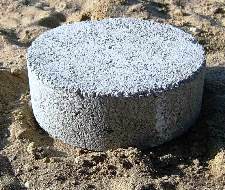My home outside of Spokane, Washington is located in an area which is subjected to a variety of weathering patterns which can prove to be stressful to concrete flatwork. Being on a lake, subjects concrete to high humidity, due to the amount of moisture in the area. Added to this, my home is in an area which has its own micro-climate. It is not unusual to see several feet of snow, when not a 30 minute drive away there will be no snow at all. Most winters will see temperatures drop below zero for several weeks, and 15 to 20 below is not an unusual event.
When my pole building garage floor was poured, it was a large enough area to require more than a single truckload of ready mixed concrete. On the day it was poured, temperatures hovered just above freezing. The first load was fairly wet, the second load, a “clean up” was a leftover from another pour in the area, and must have had an accelerator, such as calcium chloride added to it, as even though it was delivered several hours after the first load, it cured far quicker than the first pour.
All of these factors contributed to a finished pour which has not held up well at all – it has dramatically spalled.
 Spalling concrete is concrete which has broken up, flaked, or become pitted. This is usually the result of a combination of poor installation and environmental factors which stress the concrete, causing it to become damaged. On a low level, it can be purely cosmetic in nature, but it can also result in structural damage, such as damage to reinforcing bars positioned inside the concrete. For this reason, it is important to address spalling when it first starts to appear.
Spalling concrete is concrete which has broken up, flaked, or become pitted. This is usually the result of a combination of poor installation and environmental factors which stress the concrete, causing it to become damaged. On a low level, it can be purely cosmetic in nature, but it can also result in structural damage, such as damage to reinforcing bars positioned inside the concrete. For this reason, it is important to address spalling when it first starts to appear.
The signs of spalling are easy to spot. The surface will become rough and flaky, and may pit. In some cases, chunks of concrete break loose from the installation. The concrete can also start to crack, especially if large chunks break off. It can be repaired by totally removing the damaged section of concrete and filling it in with new concrete.
The best time to address spalling is when concrete is first poured, by taking steps to prevent it from occurring in the first place. The concrete should be mixed with the right amount of water, and ideally the mix kept as dry as possible because high water content can weaken the material. It also needs time to cure properly and should be handled carefully during curing. Sealing the concrete can also protect it from the elements.
If signs of deterioration are spotted in a concrete installation, it is best to act quickly to address them. The longer concrete is allowed to crack, pit, chip and flake, the higher the risk of serious damage.
In the case of my own floor, spalling is so bad, the solution is going to be to chip out all of the concrete, and repour the floor.






